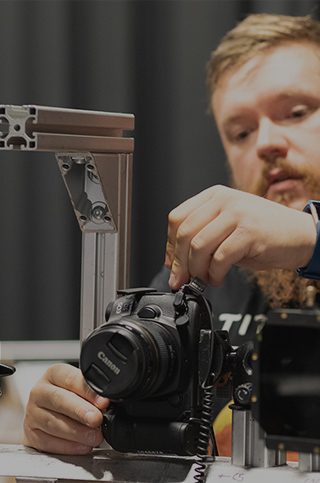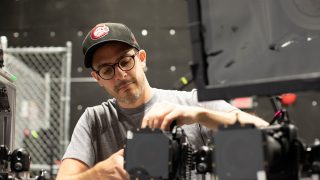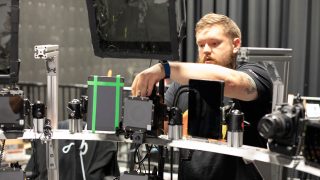In Their Own Words – Scanning the Stars of Modern Football
Sam Mynott and Paul Boulet travel across the globe to capture the likenesses of today’s top football players

In FIFA 19, Champions Rise, dreams are achieved, and legends are made in the UEFA Champions League. To remain authentic to The World’s Game, Acquisition Specialist Sam Mynott and Motion Capture System Specialist Paul Boulet from EA Vancouver travel the world, recreating the in-game likeness of many of today’s footballing stars. Learn more about them and their work for the EA Motion Capture Studio.
First off, can you tell us a bit about yourselves?
Paul: My name is Paul Boulet, I’ve been working at Electronic Arts for a total of four years. I studied 3D modelling and animation post-secondary, which led to me securing a position at EA in the Motion Capture Studio.
Sam: My name is Sam Mynott and I’ve been working in the Motion Capture Studio since 2006.

“We do so many setups and teardowns that efficiency and teamwork is indispensable.”
Acquisition Specialist Sam Mynott
How did you both get jobs working on FIFA, scanning top football players around the world?
Paul: I was very lucky and got hired on as a Motion Capture Assistant, almost right out of school. It was only a short contract at first, but I worked as hard as I could and made a good enough impression on the team for them to hire me back.
Sam: Back in 2006 I studied Broadcast Television and was planning on working as either a video editor or in film production. I found the job listing on Craigslist, applied and was offered an interview. Everything I know about motion capture and 3D scanning, I learnt on the job.
Your job means travelling a lot and visiting many big clubs around the world to scan their players. How does it feel to be on the road for so long?
Sam: I travel so much for work that I’m pretty used to it - both Paul and I have spent over four months each on the road in the previous year. It can become a long time away from home, but we get to see countries in a way that we otherwise wouldn’t probably be able to.

“The biggest thing is photography knowledge and familiarity with the scanning software, to know what is required from the images to create a quality scan.”
Motion Capture System Specialist Paul Boulet
Can you describe how the face scanning technology works exactly?
Paul: The face scanning technology uses a process called photogrammetry, which basically creates a map of a person’s face using photographs. We take all the photos and the team here in Vancouver starts the process of creating each of the players heads. The images are run through special programs, which look at each picture, and the software finds “unique identifiers” - details such as freckles or skin pores. Once all these images are compared, the software then creates a map of that players face. By using these unique identifiers and that map, their 3D representation can then be created.
Each head scan then goes to artists who refine them, as raw scans are generally a bit rough. The Artists smooth out rough portions of each scan, then using the original pictures of the footballers as reference material, a final modelling and texture pass is completed to ensure the 3D heads are as authentic looking as possible.
Do you need special skills to make the scans?
Paul: The biggest thing is photography knowledge and familiarity with the scanning software, to know what is required from the images to create a quality scan.
Sam: Knowledge of the specific cameras and the proprietary scanning software we use is very important. The required intimate knowledge of our physical setup and workflows only comes through experience. Attention to detail is crucial as well, as camera aiming is very tight and the depth of field for focus is very shallow. We do so many setups and teardowns that efficiency and teamwork is indispensable.
Isn’t there an awful lot of equipment that needs to be transported to each club?
Paul: There is! There are eleven cases worth of gear, which totals about 550 pounds worth of equipment. Including cameras, miniature PC’s, the metal parts of the rig itself, lights and stands…
You have both worked in this field collectively for a number of years. What improvements have been made to the scanning process since you started?
Sam: The rig has gotten smaller and the cameras and capture software have gotten better. In previous years, the rig used to be a full 360 degree capture inside of a tent, with lights outside of the tent for soft, diffused lighting. Now we use a 180-degree rig, no tent and smaller lights. Polarized lighting has improved the quality of the scans and how they interact with game engine lighting. There are new developments in the works that reduce the amount of gear even further, which will make it easier to capture more teams in less time, with less effort from the operator.
How does your work scanning footballers faces improve FIFA games?
Paul: The biggest thing that head scans do is to bring more realism and immersion to the game. I don’t think anyone wants to play a game using their favorite footballers when these look nothing like themselves in real life.
During your work, did you get to scan your favourite player?
Sam: As a Canadian, hockey has my heart, so I’m only a casual football fan. It’s cool to meet the players though, they’re usually pretty excited to get scanned as most of them play FIFA themselves.
How does it feel working with professional footballers, considering a lot of them play FIFA and know this game in and out? Does that put more pressure on you?
Paul: It is really awesome working with the footballers, almost all of them do play FIFA, but only a few of them ever actually ask us about their in-game faces and stats. Overall, everyone is really excited to go through the process, of having their head scanned for the game.
Sam: Football players are great to work with and are very respectful. Most of them play FIFA and are usually excited to be there, which makes our job easier. We are just one small part of a very large team, so I don’t think it puts any extra pressure on us.
After a long time on the road, what are you looking forward to the most when you head home to Canada?
Paul: Sleeping in my own bed and seeing my family and friends. There’s no place like home.
Sam: Eating a home cooked meal and sleeping in my own bed.
Do you have what it takes to bring amazing games to life? Learn more about our current opportunities here.
______________________
Stay in the conversation of all things EA: Read our blog, follow us on Twitter and Like us on Facebook.

